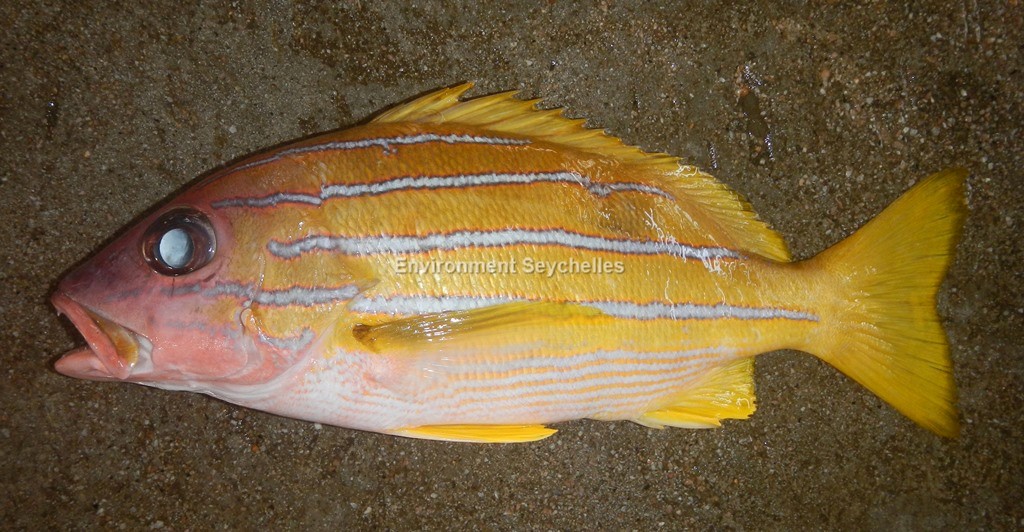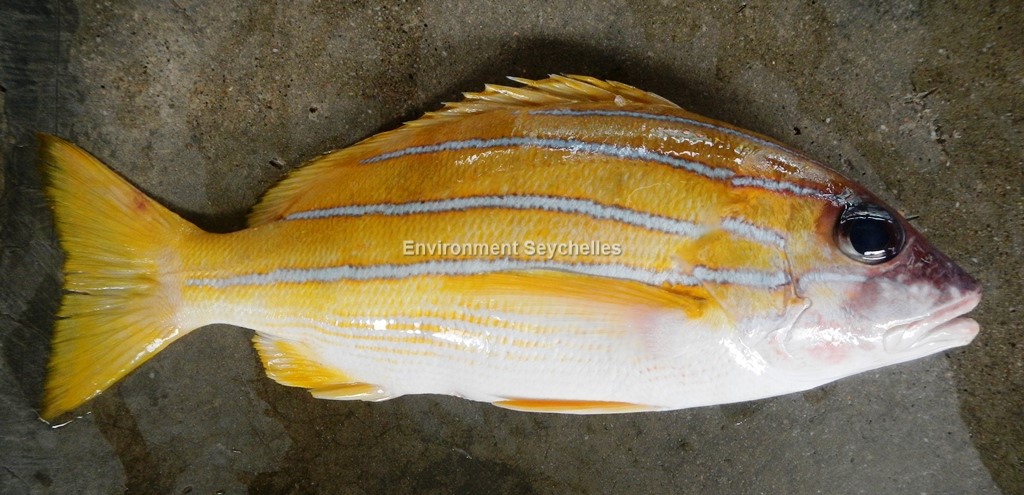Description:
Dorsal spines: 10; Dorsal rays: 14-15; Anal spines: 3; Anal rays: 7-8.
Body moderately deep. Posterior profile of dorsal and anal fins somewhat angular.
Colour. Bright yellow dorsally and laterally with four, dark edged, light blue stripes. White ventrally with several thin yellow stripes which distinguish it from the
Bengal snapper (L. bengalensis). Fins yellow. Black spot sometimes visible on lateral line below middle of dorsal fin.
Size:
Maturity: Lm unknown. Range 17-25 cm TL. Max Length: 40 cm TL. Commonly 25 cm TL.
(Heemstra: matures at 18-23 cm TL).
Habitat and Ecology:
Inhabits coral and rocky reefs, occurring in both shallow lagoons and outer reef slopes (depth 3-265 m, usually 15-40 m). Juveniles inhabit seagrass beds around patch reefs.
Feeds mostly on fishes, and also consumes a variety of crustaceans. Frequently found in large aggregations around coral formations, caves or wrecks during daylight hours.
This species displays high site-fidelity. Spawns in small groups.
Fishery Status:
This species is not protected or subject to fishery regulations. It is caught in the fish trap and the hand line fisheries, it is a regular but not usually abundant
component of the catch.
Notes:
Shares the Creole name “Madras” with L. bengalensis.
References:
Allen, G.R. (1985). FAO Species Catalogue. Vol. 6 Snappers of the World. UNFAO Rome 1985.
Bray, D.J. (2019). Lutjanus kasmira in Fishes of Australia, http://fishesofaustralia.net.au/home/species/559 (26/03/19).
Froese, R. & D. Pauly. (Eds.) (2018). FishBase. https://www.fishbase.se/summary/Lutjanus-kasmira.html (26/03/19).
Heemstra P & Heemstra, E. (2004). Coastal Fishes of Southern Africa. NISC SAIAB. ISBN: 1-920033-01-7.
Nevill, J. (2013). A Species Identification Guide for Commonly Caught Fish in the Seychelles Near-Shore Artisanal Fishery. GOS/UNDP/GEF.
Russell, B. et al. (2016). Lutjanus kasmira. The IUCN Red List 2016: http://dx.doi.org/10.2305/IUCN.UK.2016-3.RLTS.T194337A2314753.en. (26/03/19).
Citation:
Nevill, J.E.G. (2019). Lutjanus kasmira, Common bluestripe snapper. Seychelles Seatizens. www.seatizens.sc. https://seatizens.sc/species/lutjanus-kasmira-forsskal-1775/ (edited 20/07/22).




pin up az https://azerbaijancuisine.com/# pin up apk yukle
pin up giris
pin up 360: pin up yukle – pin-up kazino
https://northern-doctors.org/# purple pharmacy mexico price list
medicine in mexico pharmacies mexican pharmacy mexican online pharmacies prescription drugs
п»їbest mexican online pharmacies: Mexico pharmacy that ship to usa – mexico drug stores pharmacies
best online pharmacies in mexico: northern doctors pharmacy – medicine in mexico pharmacies
http://northern-doctors.org/# п»їbest mexican online pharmacies
https://northern-doctors.org/# mexico pharmacies prescription drugs
п»їbest mexican online pharmacies mexican pharmacy п»їbest mexican online pharmacies
http://northern-doctors.org/# mexican drugstore online
medicine in mexico pharmacies: mexican pharmacy – mexican online pharmacies prescription drugs
mexico pharmacies prescription drugs mexican pharmacy buying from online mexican pharmacy
https://northern-doctors.org/# mexico drug stores pharmacies
http://northern-doctors.org/# mexican pharmaceuticals online
https://northern-doctors.org/# mexican pharmacy
http://northern-doctors.org/# reputable mexican pharmacies online
https://northern-doctors.org/# medication from mexico pharmacy
mexican rx online mexican northern doctors mexican border pharmacies shipping to usa
What a great read! The humor was a nice touch. For further details, click here: READ MORE. Let’s chat about it!
https://northern-doctors.org/# mexican pharmaceuticals online
https://northern-doctors.org/# mexican online pharmacies prescription drugs
https://northern-doctors.org/# buying prescription drugs in mexico online
medicine in mexico pharmacies mexican pharmacy mexico drug stores pharmacies
http://northern-doctors.org/# mexican rx online
https://northern-doctors.org/# purple pharmacy mexico price list
http://northern-doctors.org/# medicine in mexico pharmacies
https://northern-doctors.org/# mexican drugstore online
buying from online mexican pharmacy northern doctors pharmacy mexico pharmacies prescription drugs
mexican mail order pharmacies buying prescription drugs in mexico online medicine in mexico pharmacies
canada drugs online certified canadian international pharmacy canadian compounding pharmacy
http://indiapharmast.com/# indian pharmacy paypal
online pharmacy india online pharmacy india best india pharmacy
canadapharmacyonline legit: pharmacies in canada that ship to the us – canadianpharmacyworld
mexico pharmacies prescription drugs reputable mexican pharmacies online buying prescription drugs in mexico
top 10 online pharmacy in india: buy medicines online in india – indian pharmacy online
http://canadapharmast.com/# canadianpharmacyworld
canada rx pharmacy: northern pharmacy canada – buying drugs from canada
ordering drugs from canada: legit canadian pharmacy – canadian drug prices
indian pharmacy paypal: indian pharmacies safe – buy medicines online in india
http://indiapharmast.com/# india online pharmacy
canada drug pharmacy: canadian world pharmacy – onlinecanadianpharmacy
how to get amoxicillin over the counter: amoxicillin price canada – amoxicillin 500mg capsule cost
amoxicillin 250 mg: amoxicillin online without prescription – generic amoxil 500 mg
http://paxloviddelivery.pro/# paxlovid covid
500 mg doxycycline pill: doxycycline over the counter australia – doxycycline 50mg tablets
https://ciprodelivery.pro/# ciprofloxacin
paxlovid buy: paxlovid pharmacy – paxlovid cost without insurance
paxlovid buy: paxlovid pill – п»їpaxlovid
can you buy generic clomid pill: how to get cheap clomid price – can i buy generic clomid no prescription
where to buy cheap clomid without insurance: buying cheap clomid without dr prescription – where buy cheap clomid without prescription